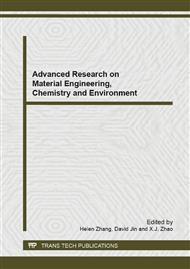p.237
p.241
p.246
p.253
p.258
p.263
p.268
p.275
p.279
Co-Oxidation Effects of Methanol on Reactive Orange 7 and Polyvinyl Alcohol in Supercritical Water
Abstract:
Methanol acting as co-oxidation component was introduced in supercritical water oxidation experiments of Reactive Orange 7 and polyvinyl alcohol. Experiments were performed at 673K and 25MPa. The concentrations of Reactive Orange 7 and polyvinyl alcohol were constant at 5wt% and 1wt%, respectively, with increasing methanol concentrations. For the binary mixture of methanol/ Reactive Orange 7, the experiment results showed that the total nitrogen and total organic carbon removals in the mixture were higher than that in the absence of methanol, and as methanol concentration increased, the accelerating effect was more notable. For methanol/polyvinyl alcohol mixture experiment, at the oxidation coefficient of 2.0, the presence of methanol (0.2-1.5 wt%) accelerated the decomposition rates of polyvinyl alcohol and total organic carbon, while methanol addition showed negative effects at the oxidation coefficient of 1.05. The inhibition reaction was attributed to the increment in induction time of polyvinyl alcohol oxidation in the presence of methanol.
Info:
Periodical:
Pages:
258-262
Citation:
Online since:
September 2013
Authors:
Price:
Сopyright:
© 2013 Trans Tech Publications Ltd. All Rights Reserved
Share:
Citation:


